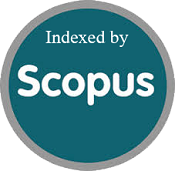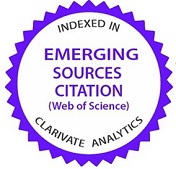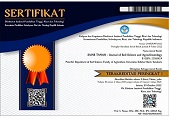Dynamics of soil fertility and rice productivity in irrigated rice fields under different cropping patterns
Abstract
Keywords
Full Text:
PDFReferences
Adhikary, P. P., Mohanty, S., Rautaray, S. K., Manikandan, N., & Mishra, A. (2023). Alternate wetting and drying water management can reduce phosphorus availability under lowland rice cultivation irrespective of nitrogen level. Environmental Monitoring and Assessment, 195(12), 1420. https://doi.org/10.1007/s10661-023-12052-5
Agustiani, N., Margaret, S., Sujinah, & Yusuf, A. M. (2018). Interaksi varietas dan penerapan sistem tanam legowo terhadap peningkatan hasil padi. Prosiding Balai Besar Penelitian Tanaman Padi (BB Padi), 251–260.
Arinta, K., & Lubis, I. (2018). Pertumbuhan dan Produksi Beberapa Kultivar Padi Lokal Kalimantan [Growth and Production of Several Local Rice Varieties in Kalimantan]. Buletin Agrohorti, 6(2), 270-280. https://doi.org/10.29244/agrob.v6i2.18943
Arouna, A., Dzomeku, I. K., Shaibu, A.-G., & Nurudeen, A. R. (2023). Water Management for Sustainable Irrigation in Rice (Oryza sativa L.) Production: A Review. Agronomy, 13(6), 1522. https://doi.org/10.3390/agronomy13061522
Arpindra Surya, J., Nuraini, Y., & Widianto, W. (2017). Kajian porositas tanah pada pemberian beberapa jenis bahan organik di perkebunan kopi robusta [Study of The Porosity of The Soil in The Provision of Different Types of Organic Material in Robusta Coffee Plantations]. Jurnal Tanah dan Sumberdaya Lahan, 4(1), 463-471. https://jtsl.ub.ac.id/index.php/jtsl/article/view/160
Aziez, A. F. (2017). Analisis pertumbuhan varietas lokal dan unggul padi sawah pada budidaya secara organik [Analysis of The Growth of Local and Superior Varieties of Paddy Rice in The Organic Farming System]. JURNAL ILMIAH AGRINECA, 17(2). https://ejournal.utp.ac.id/index.php/AFP/article/view/644
Barrow, N. J. (2017). The effects of pH on phosphate uptake from the soil. Plant and Soil, 410(1), 401-410. https://doi.org/10.1007/s11104-016-3008-9
Bhatnagar, D. V. K., & Khan, D. S. (2024). Rice Matters: From Household Love to Global Trade. IIUM Journal of Case Studies in Management, 15(1). https://doi.org/10.31436/ijcsm.v15i1.222
Biswas, S., Singh, P., Rahaman, R., Patil, K. V., & De, N. (2023). Soil quality and crop productivity under 34 years old long-term rainfed rice based cropping system in an Inceptisol of sub-tropical India [Original Research]. Frontiers in Soil Science, Volume 3 - 2023. https://doi.org/10.3389/fsoil.2023.1155712
Bozarovich, K. J., Ogli, B. S. F., & Abdivaitovich, A. S. (2023). Rice Growth and Development. Science and Innovation International Scientific Journal, 2(9), 97–102. https://scientists.uz/uploads/202309/D-15.pdf
Chairunnisak, C., Sugiyanta, S., & Santosa, E. (2018). Nitrogen Use Efficiency of Local and National Aromatic Rice Varieties in Indonesia. Journal of Tropical Crop Science, 5(3), 79-88. https://doi.org/10.29244/jtcs.5.3.79-88
Dewi, R. S., Sumarsono, S., & Fuskhah, E. (2021). Pengaruh pembenah tanah terhadap pertumbuhan dan produksi tiga varietas padi pada tanah asal karanganyar berbasis pupuk organik bio-slurry [The Effect of Soil Conditioner on the Growth and Production of Three Rice Varieties on Karanganyar Soil Based on Bio-Slurry Organic Fertilizer]. BUANA SAINS, 21(1), 65-76. https://jurnal.unitri.ac.id/index.php/buanasains/article/view/2759
Ding, C., Du, S., Ma, Y., Li, X., Zhang, T., & Wang, X. (2019). Changes in the pH of paddy soils after flooding and drainage: Modeling and validation. Geoderma, 337, 511-513. https://doi.org/10.1016/j.geoderma.2018.10.012
Dou, F., Soriano, J., Tabien, R. E., & Chen, K. (2016). Soil Texture and Cultivar Effects on Rice (Oryza sativa, L.) Grain Yield, Yield Components and Water Productivity in Three Water Regimes. PLOS ONE, 11(3), e0150549. https://doi.org/10.1371/journal.pone.0150549
Eviati, Sulaeman, Herawaty, L., Anggria, L., Usman, Tantika, H. E., . . . Wuningrum, P. (2023). Petunjuk Teknis Analisis Kimia Tanah, Tanaman, Air, dan Pupuk (3rd ed.). Soil and Fertilizer Instrument Standard Testing Center, Ministry of Agriculture of the Republic of Indonesia. https://tanahpupuk.bsip.pertanian.go.id/berita/juknis-analisis-kimia-edisi-3-acuan-prosedur-analisis-tanah-tanaman-air-dan-pupuk
Faisal, Lubis, I., Junaedi, A., & Sopandie, D. (2024). Tailoring nitrogen fertilizer regimes to complement growth dynamics of diverse rice genotypes. International Journal of Agricultural Technology, 20(6), 2271-2282. http://www.ijat-aatsea.com/pdf/v20_n6_2024_November/5_IJAT_20(6)_2024_Faisal--1537.pdf
FAO. (2007). The future of large rice-based irrigation systems in Southeast Asia. FAO Regional Office for Asia and the Pacific. RAP Publication. https://openknowledge.fao.org/server/api/core/bitstreams/8459e915-0d8c-4caa-bbb8-12a549cf6253/content
Ghimire, R., Machado, S., & Bista, P. (2017). Soil pH, Soil Organic Matter, and Crop Yields in Winter Wheat–Summer Fallow Systems. Agronomy Journal, 109(2), 706-717. https://doi.org/10.2134/agronj2016.08.0462
Guo, J. H., Liu, X. J., Zhang, Y., Shen, J. L., Han, W. X., Zhang, W. F., . . . Zhang, F. S. (2010). Significant Acidification in Major Chinese Croplands. Science, 327(5968), 1008-1010. https://doi.org/10.1126/science.1182570
Hakim, E. S. M. (2021). Analisa Daya Regenerasi Kalus Padi (Oryza sativa L.) Mentik Wangi, Mentik Wangi Susu, dan Tarabas pada Beberapa Kombinasi Kinetin dan BAP [Undergraduate thesis Faculty of Agriculture. Universitas Jember]. https://repository.unej.ac.id/handle/123456789/104192
Huo, C., Luo, Y., & Cheng, W. (2017). Rhizosphere priming effect: A meta-analysis. Soil Biology and Biochemistry, 111, 78-84. https://doi.org/10.1016/j.soilbio.2017.04.003
Islam, M. R., Singh, B., & Dijkstra, F. A. (2022). Stabilisation of soil organic matter: interactions between clay and microbes. Biogeochemistry, 160(2), 145-158. https://doi.org/10.1007/s10533-022-00956-2
Jin, Z., Shah, T., Zhang, L., Liu, H., Peng, S., & Nie, L. (2020). Effect of straw returning on soil organic carbon in rice–wheat rotation system: A review. Food and Energy Security, 9(2), e200. https://doi.org/10.1002/fes3.200
Jones, D. L., Hodge, A., & Kuzyakov, Y. (2004). Plant and mycorrhizal regulation of rhizodeposition. New Phytologist, 163(3), 459-480. https://doi.org/10.1111/j.1469-8137.2004.01130.x
Jones, D. L., Nguyen, C., & Finlay, R. D. (2009). Carbon flow in the rhizosphere: carbon trading at the soil–root interface. Plant and Soil, 321(1), 5-33. https://doi.org/10.1007/s11104-009-9925-0
Kristamtini, Widyayanti, S., & Rahayu, S. (2011). Respon padi lokal mentik wangi terhadap pendekatan teknologi SRI (System of Rice Intensification) dan PTT (Pengelolaan Tanaman Terpadu). Widyariset, 14(3), 565-570. https://core.ac.uk/download/pdf/304736533.pdf
Kuzyakov, Y. (2002). Review: Factors affecting rhizosphere priming effects. Journal of Plant Nutrition and Soil Science, 165(4), 382-396. https://doi.org/10.1002/1522-2624(200208)165:4<382::AID-JPLN382>3.0.CO;2-#
Kuzyakov, Y. (2010). Priming effects: Interactions between living and dead organic matter. Soil Biology and Biochemistry, 42(9), 1363-1371. https://doi.org/10.1016/j.soilbio.2010.04.003
Li, Z., Azeem, S., Zhang, Z., Li, Z., Zhao, H., & Lin, W. (2016). Promising Role of Moderate Soil Drying and Subsequent Recovery Through Moderate Wetting at Grain-Filling Stage for Rice Yield Enhancement. Journal of Plant Growth Regulation, 35(3), 838-850. https://doi.org/10.1007/s00344-016-9587-0
Liang, C., Schimel, J. P., & Jastrow, J. D. (2017). The importance of anabolism in microbial control over soil carbon storage. Nature Microbiology, 2(8), 17105. https://doi.org/10.1038/nmicrobiol.2017.105
Luo, W., Chen, M., Kang, Y., Li, W., Li, D., Cui, Y., . . . Luo, Y. (2022). Analysis of crop water requirements and irrigation demands for rice: Implications for increasing effective rainfall. Agricultural Water Management, 260, 107285. https://doi.org/10.1016/j.agwat.2021.107285
Maneepitak, S., Ullah, H., Paothong, K., Kachenchart, B., Datta, A., & Shrestha, R. P. (2019). Effect of water and rice straw management practices on yield and water productivity of irrigated lowland rice in the Central Plain of Thailand. Agricultural Water Management, 211, 89-97. https://doi.org/10.1016/j.agwat.2018.09.041
Maryana, Y. E., Suprihatin, A., Raharjo, B., & Sri Ratmini, N. P. (2022). Increasing Paddy Productivity in Tidal Low Lands of South Sumatra through the Implementation of New Superior Varieties and Amator. Jurnal Lahan Suboptimal : Journal of Suboptimal Lands, 11(1), 59-66. https://doi.org/10.36706/jlso.11.1.2022.557
Marzuki, M. I., Yassi, A., & Amin, A. R. (2016). Uji potensi beberapa varietas padi non-hibrida (Oryza sativa l) pada daerah pola hujan moonson. Jurnal Agrotan, 2(1), 8-21. https://ejournals.umma.ac.id/index.php/agrotan/article/view/512
Murnita, M., & Taher, Y. A. (2021). Dampak pupuk organik dan anorganik terhadap perubahan sifat kimia tanah dan produksi tanaman padi (Oriza sativa L.). Menara Ilmu: Jurnal Penelitian dan Kajian Ilmiah, 15(2). https://jurnal.umsb.ac.id/index.php/menarailmu/article/view/2314/
Nugroho, P. J., Sumarsono, S., & Sutarno, S. (2021). Pertumbuhan Dan Hasil Tanaman Padi Varietas Inpari 23 Pada Tiga Jenis Tanah Yang Mendapat Pembenah Tanah dengan Berbasis Pupuk Organik Bio-Slurry. Agrisaintifika: Jurnal Ilmu-Ilmu Pertanian, 5(2), 124-132. https://doi.org/10.32585/ags.v5i2.1961
Othmani, O., Khanchoul, K., Boubehziz, S., Bouguerra, H., Benslama, A., & Navarro-Pedreño, J. (2023). Spatial Variability of Soil Erodibility at the Rhirane Catchment Using Geostatistical Analysis. Soil Systems, 7(2), 32. https://doi.org/10.3390/soilsystems7020032
Pausch, J., & Kuzyakov, Y. (2018). Carbon input by roots into the soil: Quantification of rhizodeposition from root to ecosystem scale. Global Change Biology, 24(1), 1-12. https://doi.org/10.1111/gcb.13850
Penn, C. J., & Camberato, J. J. (2019). A Critical Review on Soil Chemical Processes that Control How Soil pH Affects Phosphorus Availability to Plants. Agriculture, 9(6), 120. https://doi.org/10.3390/agriculture9060120
Pratama, F. A., & Masitoh, F. (2023, 2023-12-29T17:00:00.000Z). Optimization Cropping Pattern of Palaan Secondary Plot Ngajum Irrigation Area Malang Regency. https://doi.org/10.2991/978-2-38476-168-5_8
Pratiwi, R. H., Supriyanta, S., & Kurniasih, B. (2018). Identifikasi Genotipe Padi ( Oryza sativa L.) Hemat Air [hemat air, macak-macak, padi sawah]. 2018, 7(2), 15. https://doi.org/10.22146/veg.35772
Qoni’ah, S. A., Parjanto, & Yunus, A. (2021). Selection of M5 short-stemmed mutants from 200 gray gamma ray irradiation in Mentik Wangi rice. IOP Conference Series: Earth and Environmental Science, 637(1), 012034. https://doi.org/10.1088/1755-1315/637/1/012034
Rai, R. K., Singh, V. P., & Upadhyay, A. (2017). Chapter 17 - Soil Analysis. In R. K. Rai, V. P. Singh, & A. Upadhyay (Eds.), Planning and Evaluation of Irrigation Projects (pp. 505-523). Academic Press. https://doi.org/10.1016/B978-0-12-811748-4.00017-0
Reddy YR, H. S., Vishnu, P., Yasasvi, B., & Changade, N. M. (2022). Effect on soil fertility under different cropping sequences, irrigation levels and fertilizer doses: A. The Pharma Innovation Journal, 11(5), 2189–2193. https://www.thepharmajournal.com/archives/?year=2022&vol=11&issue=5&ArticleId=12774
Romdhoni, A. H., Prasetya, A., & Sulandari, S. (2023). Organic fertilizers and Bacillus spp increasing NPK uptake and resistance to stunting deseases of Superior and local cultivars of organic rice in Imogiri, Bantul, Indonesia. Research Square. https://doi.org/10.21203/rs.3.rs-3479706/v1
Sirappa, M., Rieuwpassa, A., & Waas, E. D. (2007). Kajian pemberian pupuk NPK pada beberapa varietas unggul padi sawah di Seram Utara [Study of NPK Fertilizer Application on Several Superior Varieties of Lowland Rice in North Seram]. Jurnal Pengkajian dan Pengembangan Teknologi Pertanian, 10(1), 124500. https://repository.pertanian.go.id/server/api/core/bitstreams/3274f004-1ffc-4b99-a52d-41fd8076858a/content
Sokol, N. W., & Bradford, M. A. (2019). Microbial formation of stable soil carbon is more efficient from belowground than aboveground input. Nature Geoscience, 12(1), 46-53. https://doi.org/10.1038/s41561-018-0258-6
Sokol, N. W., Sanderman, J., & Bradford, M. A. (2019). Pathways of mineral-associated soil organic matter formation: Integrating the role of plant carbon source, chemistry, and point of entry. Global Change Biology, 25(1), 12-24. https://doi.org/10.1111/gcb.14482
Sudaryono, T. (2017). Dissemination on rice’s new high yielding variety through demonstration farming of jajar legowo technology in East Java. Jurnal Pembangunan Dan Alam Lestari, 8(2), 98-104. https://doi.org/10.21776/ub.jpal.2017.008.02.07
Surdianto, Y., Sunandar, B., Kurnia, & Sutrisna, N. (2021). Growth and productivity of new superior rice varieties and respondents’ preference in Majalengka Regency. E3S Web Conf., 306, 01033. https://doi.org/10.1051/e3sconf/202130601033
Susanto, U., Imamuddin, A., Samaullah, M. Y., Satoto, Jamil, A., & Ali, J. (2017). Keragaan Galur-galur Green Super Rice pada Kondisi Sawah Tadah Hujansaat Musim Kemarau di Kabupaten Pati [Performance of Green Super Rice Lines under Dry Season of Rainfed Lowland Condition in Regency of Pati]. Buletin Plasma Nutfah, 23(1), 41-50. https://repository.pertanian.go.id/handle/123456789/2165
Sutaryo, B., & Pramono, J. (2016). Keragaan hasil gabah dan karakter agronomi sepuluh varietas padi unggul di Sleman, Yogyakarta [Performance of Grain Yield and Agronomic Characteristics of Ten Rice Varieties in Sleman Yogyakarta]. Agrin: Jurnal Penelitian Pertanian, 20(1). https://jurnalagrin.net/index.php/agrin/article/view/309
Syafrullah, S. (2019). Lignite-based Organic Fertilizer Improves Soil Quality and Yield of Rice in Belitang South Sumatera. Journal of Tropical Soils, 24(3), 109-117. https://doi.org/10.5400/jts.2019.v24i3.109-117
van Hees, P. A. W., Vinogradoff, S. I., Edwards, A. C., Godbold, D. L., & Jones, D. L. (2003). Low molecular weight organic acid adsorption in forest soils: effects on soil solution concentrations and biodegradation rates. Soil Biology and Biochemistry, 35(8), 1015-1026. https://doi.org/10.1016/S0038-0717(03)00144-5
Wang, P., Xie, W., Ding, L., Zhuo, Y., Gao, Y., Li, J., & Zhao, L. (2023). Effects of Maize–Crop Rotation on Soil Physicochemical Properties, Enzyme Activities, Microbial Biomass and Microbial Community Structure in Southwest China. Microorganisms, 11(11), 2621. https://doi.org/10.3390/microorganisms11112621
Wapongnungsang, Ovung, E., Upadhyay, K. K., & Tripathi, S. K. (2021). Soil fertility and rice productivity in shifting cultivation: impact of fallow lengths and soil amendments in Lengpui, Mizoram northeast India. Heliyon, 7(4), e06834. https://doi.org/10.1016/j.heliyon.2021.e06834
Wibawa, W., & Sugandi, D. (2017). Pola pembentukan anakan padi dari berbagai varietas dan jumlah bibit per lubang pada lahan suboptimal di Provinsi Bengkulu. Prosiding Seminar Nasional: Mewujudkan Kedaulatan Pangan pada Lahan Sub Optimal Melalui Inovasi Teknologi Pertanian Spesifik Lokasi, 221–228. https://repository.pertanian.go.id/handle/123456789/9128
Xu, C., Chen, Y., Zang, Q., Li, Y., Zhao, J., Lu, X., . . . Huang, L. (2023). The effects of cultivation patterns and nitrogen levels on fertility and bacterial community characteristics of surface and subsurface soil [Original Research]. Frontiers in Microbiology, Volume 14 - 2023. https://doi.org/10.3389/fmicb.2023.1072228
Yan, S., Song, J., Fan, J., Yan, C., Dong, S., Ma, C., & Gong, Z. (2020). Changes in soil organic carbon fractions and microbial community under rice straw return in Northeast China. Global Ecology and Conservation, 22, e00962. https://doi.org/10.1016/j.gecco.2020.e00962
Ye, C., Zheng, G., Tao, Y., Xu, Y., Chu, G., Xu, C., . . . Wang, D. (2024). Effect of Soil Texture on Soil Nutrient Status and Rice Nutrient Absorption in Paddy Soils. Agronomy, 14(6), 1339. https://doi.org/10.3390/agronomy14061339
Yin, Q., Liu, Y., Li, J., Wu, J., Wang, Y., Zhang, H., . . . Wang, J. (2025). Soil organic carbon formation in grassland ecosystems: Higher efficiency of roots than shoots and rhizodeposition. Soil and Tillage Research, 250, 106523. https://doi.org/10.1016/j.still.2025.106523
Yulianto. (2017). Ketahanan varietas padi lokal mentik wangi terhadap penyakit blas [Resistance to Blast Disease in Local Rice Variety Mentik wangi]. Journal of Food System and Agribusiness, 1(1), 47–54. https://doi.org/10.25181/jofsa.v1i1.83
Yunus, A., Parjanto, & Pratama, I. Y. (2018). The performance of M2 generation of Mentik Wangi Susu rice resulted from gamma ray iradiation. IOP Conference Series: Earth and Environmental Science, 142(1), 012063. https://doi.org/10.1088/1755-1315/142/1/012063
Zaini, Z., Abdurrahman, S., Widiarta, N., Wardana, P., Setyorini, D., Kartaatmadja, S., & Yamin, M. (2009). Pedoman Umum PTT Padi Sawah [General Guidelines for ICM Paddy Fields ]. Balai Penelitian dan Pengembangan Pertanian, Kementerian Pertanian. https://repository.pertanian.go.id/handle/123456789/17411
Zhang, Z., Liu, D., Wu, M., Xia, Y., Zhang, F., & Fan, X. (2021). Long-term straw returning improve soil K balance and potassium supplying ability under rice and wheat cultivation. Scientific Reports, 11(1), 22260. https://doi.org/10.1038/s41598-021-01594-8
Zhou, J., Xia, F., Liu, X., He, Y., Xu, J., & Brookes, P. C. (2014). Effects of nitrogen fertilizer on the acidification of two typical acid soils in South China. Journal of Soils and Sediments, 14(2), 415-422. https://doi.org/10.1007/s11368-013-0695-1
Refbacks
- There are currently no refbacks.











.png)





